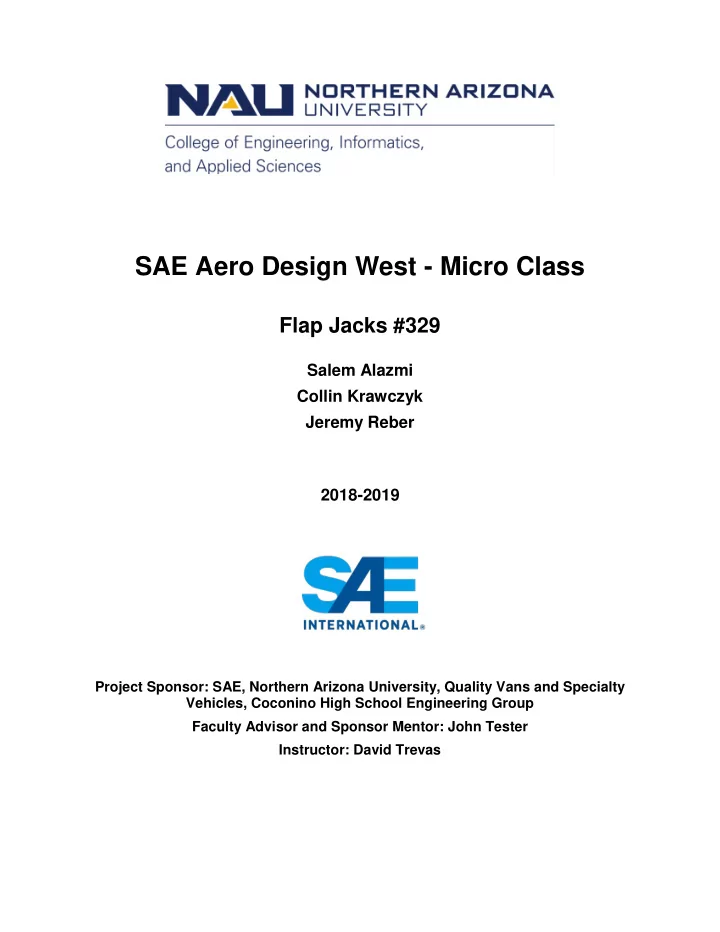

SAE Aero Design West - Micro Class Flap Jacks #329 Salem Alazmi Collin Krawczyk Jeremy Reber 2018-2019 Project Sponsor: SAE, Northern Arizona University, Quality Vans and Specialty Vehicles, Coconino High School Engineering Group Faculty Advisor and Sponsor Mentor: John Tester Instructor: David Trevas
Contents ............................................................................................................................. 4 List of Figures and Tables ...................................................................................................................... 5 List of Symbols and Acronyms 1.0 Executive Summary ................................................................................................................................ 6 1.1. System Overview ............................................................................................................................... 7 1.2. Competition Projections ..................................................................................................................... 7 1.3. Discriminators .................................................................................................................................... 8 ................................................................................................................................. 8 2.0 Schedule Summary .................................................................................................................... 8 3.0 Design Layout & Trade Offs ......................................................................................................... 8 3.1. Overall Design Layout and Size 3.2. Optimization ....................................................................................................................................... 9 ................................................................................ 9 3.2.1. Competitive Scoring and Strategy Analysis 3.2.2. Optimization and Sensitivity Analysis ......................................................................................... 9 11 3.3. Design Features and Details ............................................................................................................ 12 3.4. Interfaces and Attachments ............................................................................................................. 13 4.0 Loads and Environments, Assumptions ................................................................................................ 13 4.1. Design Loads Derivations ................................................................................................................ 13 4.2. Environmental Considerations ......................................................................................................... 14 5.0 Analysis ................................................................................................................................................. 14 5.1. Analysis Techniques ........................................................................................................................ 14 5.1.1. Analytical Tools ......................................................................................................................... 14 5.1.2. Developed Models .................................................................................................................... 14 5.2. Performance Analysis ...................................................................................................................... 14 5.2.1. Runway/Launch/Landing Performance ..................................................................................... 15 5.2.2. Flight and Maneuver Performance (Incl. Surface Sizing) ......................................................... 15 5.2.3. Shading and Downwash Analysis ............................................................................................. 18 5.2.4. Dynamic & Static Stability ......................................................................................................... 19 5.2.5. Aeroelasticity ............................................................................................................................. 20 5.2.6. Lifting Performance, Payload Prediction, and Margin ............................................................... 21 5.3. Structural Analysis ........................................................................................................................... 23 5.3.2. Mass Properties & Balance ....................................................................................................... 23 6.0 Assembly and Subassembly, Test and Integration ............................................................................... 24 7.0 Manufacturing ....................................................................................................................................... 24 8.0 Conclusion ............................................................................................................................................ 25 References .............................................................................................................................................. Appendix A – Supporting Documentation and Backup Calculations ...................................................... 26 Appendix B – Technical Data Sheet ....................................................................................................... 27 28 Drawing 11x17 ........................................................................................................................................
List of Figures and Tables ........................................................................................................10 Figure 1: Thrust vs. Speed Figure 2: Lift vs. drag at varying angle of attacks ......................................................................16 Figure 3: Drag vs. velocity at varying Reynolds numbers ..........................................................17 Figure 4: Cruise drag with downwash effects ............................................................................18 Figure 5: Cantilever beam with distributed loading [8] ...............................................................19 ...............................................................................................21 Figure 6: Lift generated at cruise ..........................................................................26 Figure 7: Rules of thumb for plane design [10] Table 1: Aircraft components ....................................................................................................12 Table 2: Load assumptions .......................................................................................................13 .........................................................................................................20 Table 3: Deflection results ...........................................................................................22 Table 4: Wing support components ........................................................................................................23 Table 5: Building materials
List of Symbols and Acronyms 𝜀 𝐶 Maximum deflection at B 𝜍 ∞ Density upstream 𝜈 Dynamic viscosity ABS Acrylonitrile Butadiene Styrene AR Aspect ratio b Wing length e Wing Oswald efficiency factor c Wing chord length 𝑑̅ Wing mean aerodynamic chord c.g. Center of gravity 𝐷 𝐸 Coefficient of drag 𝐷 𝐸,𝑗 Induced drag 𝐷 𝐸,𝑝 Parasitic drag at zero lift 𝐷 𝑀 Coefficient of Lift CAD Computer aided design D Drag E Modulus of elasticity I Moment of inertia L Lift 𝑀 𝐵𝐶 Length of beam from A to B 𝑚 𝑢 Distance from vehicle center of gravity to tail quarter chord q Declining distributed load 𝑟 ∞ Dynamic pressure upstream Re Reynolds Number RC Remote controlled S Wing planform area 𝑇 𝑢 Tail planform area SAE Society of automotive engineers 𝑊 𝐼 Horizontal tail volume ratio 𝑊 ∞ Velocity upstream
1.0 Executive Summary The SAE Aero West design competition teaches students how to complete a year-long project and successfully design aspects of an aircraft. The micro class competition focuses on specific components of aircraft such as assembly and disassembly, weight minimization, and payload attachments. The micro aircraft that the team at Northern Arizona University designed was created to meet the competition requirements and uses a Clark Y 11.4% airfoil, an RC plane racing motor, a 7 ” x4 ” propeller, a unique bolt payload attachment system, and modular sub assembly attachment systems for the tail, wing, and fuselage. Based on initial calculations, the lift and drag generated for cruise by the wing at 30 mph is 1.4 lbs. and 0.12 lbs., respectively. The maximum dynamic thrust produced is 1.4 lbs. at 30 mph, which is much greater than the drag that is generated. The maximum weight of the aircraft is 0.9 lbs. and can carry approximately 0.3 - 0.5 lbs. of payload. The modular designs use brackets and pins to attach subassemblies and meets the competition requirement of fitting within a fixed volume box and the requirement of assembling the aircraft within a specific time frame. Based upon the competition requirements and the design of the aircraft, the aircraft should place within the top five of teams in the micro class competition.
Recommend
More recommend